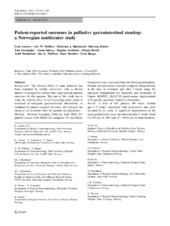| dc.contributor.author | Larssen, Lene | en_US |
| dc.contributor.author | Medhus, Asle W. | en_US |
| dc.contributor.author | Hjermstad, Marianne J. | en_US |
| dc.contributor.author | Kørner, Hartwig | en_US |
| dc.contributor.author | Glomsaker, Tom Birger | en_US |
| dc.contributor.author | Søberg, Taran | en_US |
| dc.contributor.author | Gleditsch, Dagfinn | en_US |
| dc.contributor.author | Hovde, Øistein | en_US |
| dc.contributor.author | Nesbakken, Arild | en_US |
| dc.contributor.author | Tholfsen, Jan K. | en_US |
| dc.contributor.author | Skreden, Knut | en_US |
| dc.contributor.author | Hauge, Truls | en_US |
| dc.date.accessioned | 2011-11-23T14:07:31Z | |
| dc.date.available | 2011-11-23T14:07:31Z | |
| dc.date.issued | 2011-04-13 | eng |
| dc.Published | Surgical Endoscopy 25(10): 3162-3169 | en |
| dc.identifier.issn | 0930-2794 | |
| dc.identifier.uri | https://hdl.handle.net/1956/5226 | |
| dc.description.abstract | Background The clinical effect of stent treatment has been evaluated by mainly physicians; only a limited number of prospective studies have used patient-reported outcomes for this purpose. The aim of this work was to study the clinical effect of self-expanding metal stents in treatment of malignant gastrointestinal obstructions, as evaluated by patient-reported outcomes, and compare the rating of the treatment effect by patients and physicians. Methods Between November 2006 and April 2008, 273 patients treated with SEMS for malignant GI and biliary obstructions were recruited from nine Norwegian hospitals. Patients and physicians assessed symptoms independently at the time of treatment and after 2 weeks using the European Organisation for Research and Treatment of Cancer (EORTC) QLQ-C30 questionnaire supplemented with specific questions related to obstruction. Results A total of 162 patients (99 males; median age = 72 years) completed both assessments and were included in the study. A significant improvement in the mean global health score was observed after 2 weeks (from 9 to 18 on a 0–100 scale, P\0.03) for all stent locations. Both patients and physicians reported a significant reduction in all obstruction-related symptoms ([20 on the 0–100 scale, P\0.006) after SEMS treatment. The physicians reported a larger mean improvement in symptoms than did the patients, mainly because they reported more severe symptoms before treatment. Conclusion SEMS treatment is effective in relieving symptoms of malignant GI and biliary obstruction, as reported by patients and physicians. The physicians, however, reported a larger reduction in obstructive symptoms than did the patients. A prospective assessment of patientreported outcomes is important in evaluating SEMS treatment. | en_US |
| dc.language.iso | eng | eng |
| dc.publisher | Springer | eng |
| dc.rights | Attribution-NonCommercial 4.0 Internasjonal | |
| dc.rights.uri | http://creativecommons.org/licenses/by-nc/4.0/deed.no | eng |
| dc.subject | Gastrointestinal cancer | eng |
| dc.subject | Biliary tract neoplasm | eng |
| dc.title | Patient-reported outcomes in palliative gastrointestinal stenting: a Norwegian multicenter study | en_US |
| dc.type | Peer reviewed | |
| dc.type | Journal article | |
| dc.description.version | publishedVersion | en_US |
| dc.rights.holder | The Author(s) 2011 | |
| dc.identifier.doi | https://doi.org/10.1007/s00464-011-1680-7 | |
| dc.subject.nsi | VDP::Medical disciplines: 700::Clinical medical disciplines: 750::Oncology: 762 | eng |

